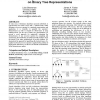195 search results - page 14 / 39 » A Multi-Stack Based Phylogenetic Tree Building Method |
BMCBI
2007
13 years 8 months ago
2007
Background: Alternative representations of biochemical networks emphasise different aspects of the data and contribute to the understanding of complex biological systems. In this ...
BMCBI
2007
13 years 8 months ago
2007
Background: Overlapping genes (OGs) in bacterial genomes are pairs of adjacent genes of which the coding sequences overlap partly or entirely. With the rapid accumulation of seque...
GECCO
2006
Springer
14 years 7 days ago
2006
Springer
In some cases, evolutionary algorithms represent individuals as typical binary trees with n leaves and n-1 internal nodes. When designing a crossover operator for a particular rep...
TCBB
2008
13 years 8 months ago
2008
Abstract-- The Maximum Parsimony problem aims at reconstructing a phylogenetic tree from DNA sequences while minimizing the number of genetic transformations. To solve this NP-comp...
JCB
2000
13 years 8 months ago
2000
Multiple sequence alignments (MSAs) are frequently used in the study of families of protein sequences or DNA/RNA sequences. They are a fundamental tool for the understanding of th...

